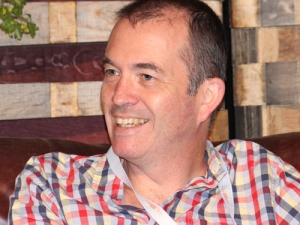Sauvignon Blanc New Zealand 2027 to unite and reinvigorate the wine industry
Sauvignon Blanc New Zealand 2027 is perfectly timed, given the period of turbulence and change in New Zealand wine, says committee chair Natalie Christensen.
 With more than 20,000 hectares of Sauvignon Blanc, New Zealand is second only to France in terms of plantings.
With more than 20,000 hectares of Sauvignon Blanc, New Zealand is second only to France in terms of plantings.
It has become the lifeblood of the New Zealand wine industry, accounting for at least $1.1 billion of the total $1.5 billion worth of wine exports.
But just where does Sauvignon Blanc sit within the world of wine and where is New Zealand's competition coming from?
Those were the questions renowned writer and academic Jamie Goode was tasked with answering at the NZSVO workshop held in Blenheim earlier this year.
Sauvignon Blanc is the 10th most widely planted grape variety in the world, with a massive total of 90,000 hectares. Trebbiano or Ugni Blanc as it is known in France is the largest with a total of 155,000 hectares. In comparison New Zealand's other flagship wine Pinot Noir, has a world hectarage of 85,000.
New Zealand is second only to France for land devoted to Sauvignon Blanc, with a total of 20,266 hectares. France has 26,304.
The two countries are way ahead of the competition, with South Africa in third (9446ha), Chile fourth (8862), Australia fifth (7010) and the US sixth with 6238.
The popularity of the variety Goode said is reflected in the growth in the top three countries.
"There has been a surge in popularity. For example in France in 1958, there were only 4860 hectares of Sauvignon. In 1968 that had grown to 8500. Now there are 26,300."
In South Africa the total percentage of hectares devoted to Sauvignon Blanc has grown from 6.7 percent in 2002 to 9.4 percent currently.
So as we move forward, where is New Zealand's competition likely to come from – is it the birthplace of the variety – or are we at risk from other new world countries? Goode says there are three threats; Chile, South Africa and France. But he described the level of threat from each as being very different. He termed Chile as being the "highest" threat. South Africa as being a moderate threat, and the risk from France as being "weak".
Chile will come as no surprise to New Zealanders. It has long been described as having a similar climate to our own especially in the cool climate areas of Casablanca and Leyda Valley.
"Coastal Colchagua make the best wines, while the Central Valley produces more of the cheap stuff," Goode said.
He described the flavours of Sauvignon Blanc emanating from Chile as "quite green with a dominance of methoxypyrazine. But the best are very fresh."
With production costs lower than here in New Zealand, Chilean Sauvignon Blanc undercuts ours in export markets. That is something this country cannot and he reiterated does not want to compete against.
South Africa is a much warmer climate generally, although Goode says there are a number of cool areas that are producing some very good Sauvignons. These include Darling, Constantia, Elgrin, Memel-en-Aarde and Elim. Consistency of quality is an issue currently he believes, which is why he places the threat level at just moderate. But if that can be remedied in the future, South Africa could become a greater threat, especially as once again their prices undercut New Zealand.
Many attending the workshop were interested to hear Goode describe France, the birthplace of the variety, as being only a "weak" threat to New Zealand in the future.
"I think one of the problems is that a lot of French Sauvignon Blanc does not actually have Sauvignon Blanc on the label. So most consumers who want to buy (this variety) would not associate Pouilly-Fume or Sancerre with Sauvignon Blanc."
Because these areas are playing at a higher end of the market, he said they were not a direct threat to New Zealand.
However the same cannot be said for Touraine, (in the Loire Valley) which is an area he believes could be a potential challenger. The quality of the wine has risen and is well priced, Goode said. "And, the wine has Sauvignon Blanc on the label."
Moving forward Goode said we need to ensure the message we are sending consumers is the right one. The KISS theory of keeping it simple cannot be underestimated, particularly when it comes to Marlborough.
"I think you need to go with the brand that Marlborough is special and it's different. It's not a complicated message, but it needs to be out there. So that when they go and buy a bottle of Sauvignon Blanc, they say they want a Marlborough Sauvignon Blanc. Sometimes we complicate it too much. The more stripped down the message can be, the more effective it is. Don't confuse the consumers."
And never forget there are threats out there, which means quality and consistency are vital. To do anything else will devalue the brand and allow someone else to slip into the position New Zealand has held for so long.

The end of the year is fast approaching, so here are some thoughts on a few of the significant developments…

OPINION: When I moved to Marlborough two decades ago, I found countless lines of tidy vines, neatly mowed and carefully…
The large 2025 harvest will exacerbate the wine industry's "lingering" supply from recent vintages, New Zealand Winegrowers Chief Executive Philip…
If you find a new consumer in a developed wine market, you are taking them from someone else, says Blank…
OPINION: Sauvignon Blanc was famously introduced to New Zealand by Ross Spence of Matua Valley, and then serendipitously planted in…